Where is Germany's Gold? James Turk Told Everyone Ten Years ago! Central Banks' US Treasury Reserves
Everyone but me seemed to be happy about how the stock market ended the week. Well, I'm a bear, and bears are more realistic about things like the approaching end of the world as we now know it. How's that? I don't have data for European bonds, but it seems to me that in the grand scheme of things, Greece is small potatoes. So, how did these Grecian spuds become a fearsome Godzilla marching towards the heart of Europe? Insane leverage via derivative contracts.
How does that work? Well, take you and your significant other; the two of you form a small economic unit. Since the loss of one of you would have a direct economic impact on the other, you take out term life insurance policies on each other's lives. The life insurance company agrees to insure each of you for $500K, as you have an insurable risk on each other. But then one of Wall Street's vampire banks sees an opportunity here, so they invent a new "financial product" called Demise Derivatives on you and your significant others' lives, which they begin marketing to large financial institutions and hedge funds. These financial entities don't even know the name of your kids, or where you live, but the "economic opportunity" of you dying in a flaming car wreck is just too tempting for them to pass up.
Before you know it, Wall Street has written demise derivatives on you and yours to the tune of a few billion dollars. Like your insurance company, Wall Street knows the chances of your dying in the next year are pretty slim, so they're willing to take the risk. But unlike your insurance company, the vampire bank maintains no reserves to pay off ghoulish hedge-fund managers in the event of your death. Well, a contract is a contract, so when members of Congress and the President took campaign contributions (bribes) from the big derivatives houses, they implicitly knew they were committed to bail out their friends on Wall Street. The American people, and now it seems Europeans taxpayers too, must be made aware of their responsibility to keep our "modern" financial system from imploding!
Are things really this bad? I suspect they're even worse! The most recent BIS derivative report listed credit default swaps' nominal valuation at $29.99 trillion dollars, but we don't know the breakdown of which bond sector is hedged, and by how much. Even US Treasury bonds have credit default swaps written on them, but logic tells us that the banks have written the bulk of these "hedging products" on the more speculative bonds such as troubled corporates & munis, and foreign sovereigns whose names we now know so well. After all, the higher the risk, the more Wall Street can charge for the hedge. And it's likely that the vast majority of these CDS's are not even true hedges at all, since their holders don't even own the underlying product in the first place. As such, these are naked bets that a bond issue will default, not portfolio protection, which was the supposed purpose for which these derivative instruments were invented.
I'd really like to know the full liability the big banks have in Greek sovereign bond derivatives. I'd be very surprised if they didn't sell a thousand dollars of insurance for every dollar of debt issued by the Greek government. This is a moral hazard no legitimate life insurance company would tolerate. If Europe doesn't find a real solution to the Greco-Roman bond situation, the global banking system could implode as counter-parties demand specific performance on contracts in the trillions of dollars. That's a lot of money. Don't be so naïve to believe that everyone wants a solution to this crisis. There are powerful people in the world, willing to do everything in their power to obstruct a workable solution to the European sovereign-bond crisis, because the unregulated-derivatives market has provided them with a financial incentive to bankrupt the world.
So, considering everything that's transpired in the past five days, what's the big deal that the Dow Jones finished upthis week on rumors of solutions to the European sovereign debt problem? Until I hear that the Tooth Fairy has pledged to support Europe in its hour of need, the long-term future for the American stock market is all pain, and no gain. Still, the bulls (according to the so-called "experts"), are looking ahead of today's credit problems, and are anticipating future higher stock prices. Look at the daily Dow Jones Advancing & Declining stats for the Week; except for Wednesday, the Advancing shares overwhelmed the decliners.

But the bear in me insists that buying stocks at these levels would be ill-advised. It's a fool's errand to risk money in the stock market until the current global credit dislocations are resolved. You may think the Dow's Advancing and Declining table above looks good, but I think it's absolutely horrible! One has to watch the final scenes of Titanic to see people running back and forth with this much enthusiasm.
And then there's the Dow's BEV plot and its 8-count to consider; since last May, the Dow can't seem to move above its BEV-10% line, and since the end of July, its 8-count can't seem to get back down to zero. What's the problem here? It's a bear market!
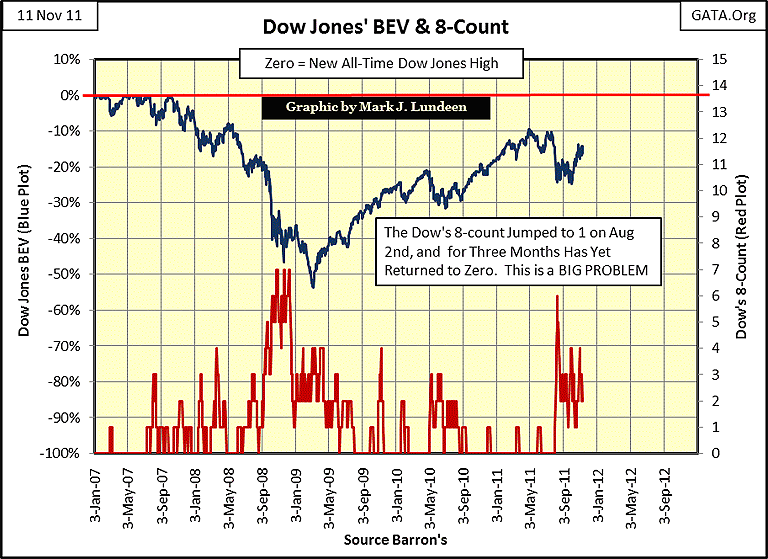
Let's not forget the NYSE's 52Wk Highs and Lows: in the past 25 trading sessions, 20 of them saw more 52Wk highs than lows. True, but until we see up days for the Dow Jones occurring with new 52Wk highs at the NYSE peaking in the 200-400s range, I won't be impressed.
Consider the following; a stock can decline one day, and advance the next. But it takes months for most stocks to move from one 52Wk extreme to the other. The last time the NYSE saw its new 52Wk Highs rise above 300 (about 10% of all stocks trading at the NYSE) was on May 2nd this year. The Dow was only a few points from its post credit crisis high on that day. That was six months ago, six months for the 3100 shares listed on the NYSE to move away from their 52Wk lows, and rise up to new 52Wk Highs. If this was a move in a real bull market, we'd be seeing NYSE 52Wk highs in the triple digits, peaking in the 200s to 400s. Instead, what do we see in the table below? We see one day of the last 25 trading sessions posting a triple digit 52Wk high. When we take the average of the NYSE 52Wk highs from the twenty up-days below, it averages only 45!
We can't use this data to derive a price-move potential for the Dow Jones. But what we can do with it is arrive at some conclusion of whether the next big move is up or down. As the Dow's declined from its highs of May was less than 18% in early October, and typically NYSE 52Wk H&L data is a leading indicator, my gut feeling when looking at the table below is that the current move doesn't have the legs to take the Dow above its October 2007 all-time high. But if the NYSE begins to see its new 52Wk highs expand, maybe the Dow could make a new all-time high in the months to come.

But suppose the stock market shows me all the signs I need to turn bullish, would I then become a bull on the stock market? Hell NO! I've been very consistent detailing my problems with stock market valuations. After the bulls have partied like animals for the past three decades, there is nothing but garbage left trading in the financial markets. The government's regulators at the SEC and CFTC have proven themselves to be corrupt or incompetent, and what is needed now is a new sheriff in town, a big furry fella with a tin-star pinned to his chest. We'll all know when he reports for duty, as he will shoot first, and ask questions later.
It had always been a point of interest to me that before the euro's introduction, European "authorities" promoted their new currency as having a 15% gold reserve backing. Well, after a decade of massive euro inflation, if Germany canlocate its gold, the euro in 2011 may might still have a 2-4% gold reserve behind it. But where are Germany's 3000 tons of gold? No one seems to know exactly where it is, which makes James Turk's * April 2001 * article on the ETF's gold follies VERY INTERESTING READING!
I know who I am, and you should too; I'm a retired US Navy Chief Petty Officer, who became fascinated with the financial markets decades ago. Mr. Turk is the informed gold market insider, who investors in gold and silver, owe more than they know. If he hadn't been writing articles on gold (like the one linked above) for over two decades, but had chosen to join the dark side of the force, I'm sure his financial situation would be substantially greater than it is now. Fortunately for us, Mr. Turk is not only an honest man, but has also had considerable success keeping track of what the "policy makers" have done with thousands of tonnes of other peoples' gold. And what have European and North American central banks been doing with their gold? I think the following 2009 quote from a Reagan era US Treasury official tells the tale.
"How long can the US government protect the dollar's value by leasing its gold to bullion dealers who sell it, thereby holding down the gold price? Given the incompetence in Washington and on Wall Street, our best hope is that the rest of the world is even less competent and even in deeper trouble. In this event, the US dollar might survive as the least valueless of the world's fiat currencies."
- Paul Craig Roberts, Assistant Secretary of the Treasury in the Reagan administration (February 2009)
In the James Turk article linked above (Behind Closed Doors), based on the Fed's January 31st, 1995 minutes (minutes that are suspiciously no longer available on the Internet) and the US Treasury's inventory reports, Mr. Turk, * TEN YEARS AGO *, suspected that Germany's gold was had been sold with the full knowledge of Germany's "monetary authorities" in a successful, long term gold price suppression scheme to keep US interest rates low, and stock prices high, during the Clinton Administration (1992-2000). Half of Germany's gold was leased to bullion banks, who then proceeded to sell it on the open market for less than $350 an ounce.
The other half of Germany's gold was swapped with US government gold. Unfortunately, the American gold reserve, though vast, is uniquely American as it is mostly coin melt from FRD's 1934 gold confiscation, whose purity is 21 karat, not the standard 24 karat purity used by central banks. The Clinton era Treasury (think Treasury Secretary Robert Rubin) was concerned that if a thousand tons of coin melt (21 karat gold) hit the London market, it could not be hidden that the US Treasury (think President Clinton and Secretary Rubin) was dishoarding America's gold. Also, the US Treasury's gold was located in North America, not Europe, where gold's wholesale market is currently located. So, Germany's 1990s "monetary authorities", being "team players", swapped their 24 karat gold for the US Treasury's 21 karat gold, receiving a paper I-Owe-You for its return. Mr. Turk has even found evidence that the US Government is currently storing 1,700 tons of Germany's gold at the US Treasury's West Point bullion storage facility (see Mr. Turks "Behind Closed Doors" for details).
So, with all the paper work completed, making everything nice and legal, the US government then leased its newly acquired 24 karat gold to a bullion bank, who sold it in London for less than $350 dollars an ounce.
I expect Mr. Turk would be the first to admit that he could be proven incorrect in all of this, should American and German officials allowed a full and independent forensic audit of their gold reserves, with its documentation. Including representatives from China and Russia in the team of auditors would guarantee the integrity of the audit findings. But for decades, facts were, (and still are) hard to come by when one investigates the secretive gold dealings of the Federal Reserve and other global central banks. But the facts uncovered in official US Government documents (used in "Behind Closed Doors") are compelling. What's ridiculous is believing that "no one knows" where Germany's gold is, because several rail-road box cars full of gold just don't disappear. What does disappear is incriminating paper work proving that during the 1990s, named-government officials delivered thousands of tonnes of their nation's gold into the hands of bullion banks that are now on the verge of bankruptcy.
Foreign central bank holdings of US T-Debt for their monetary reserves have declined in each of the past ten weeks. Since the end of August, the CBs have sold off 2.75% of their holdings of US Treasury debt (as of Barrons November 7th issue). As seen in the BEV plot below, this is the largest reduction of foreign central bank US T-debt holdings since 2001. Two possibilities could explain this reduction:
- For good reason, the long-term viability of US, AAA rated T-debt is being questioned by the world's "monetary authorities", so they are reducing their exposure to the US Treasury bonds.
- Central banks are selling US Treasury bonds to raise cash to support the bond prices of troubled European governments.
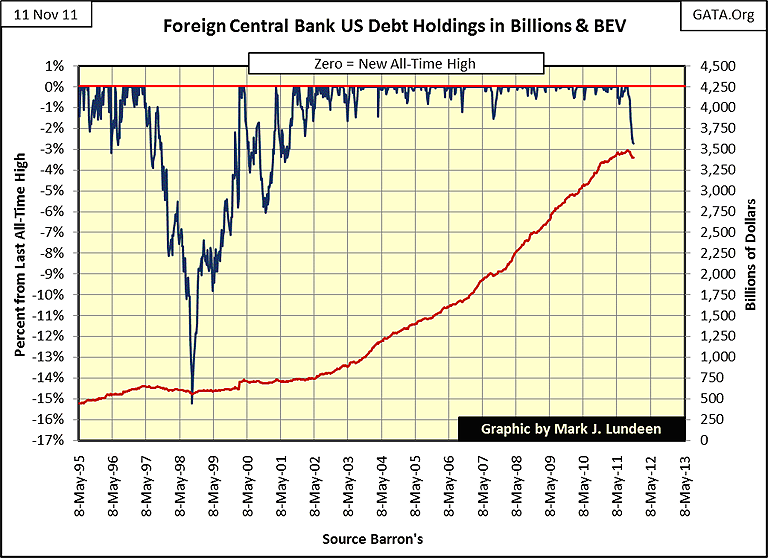
The current drawdown in CBs' US Treasury holdings is most likely a combination of the two, though in the secret world of central banking, there could be factors I'm not aware of in play. Still, since the last week of August, we have seen the largest percentage selloff of US Treasury bonds in a decade by foreign central banks. Who can say what caused this reduction to begin in August, but I think that we will look back at this ominous development in time with a better understanding of the reasons the policy makers needed to raise money, or why they decided in August to limit their risk of holding US Treasuries.
No matter, the most alarming fact seen in the chart above is that foreign CBs have increased their holdings of US T-debt by 660% in the last sixteen years (above red plot). Since "economic growth" is generally measured using units of "currency", not tonnes, barrels, or units of production, it's hard to avoid concluding that most global "growth" over the past sixteen years was only an inflationary illusion.
From the US Treasury's site listing monthly Foreign CB holdings of US Treasury debt (updated to August 2011), we see the twelve month change in the table below.
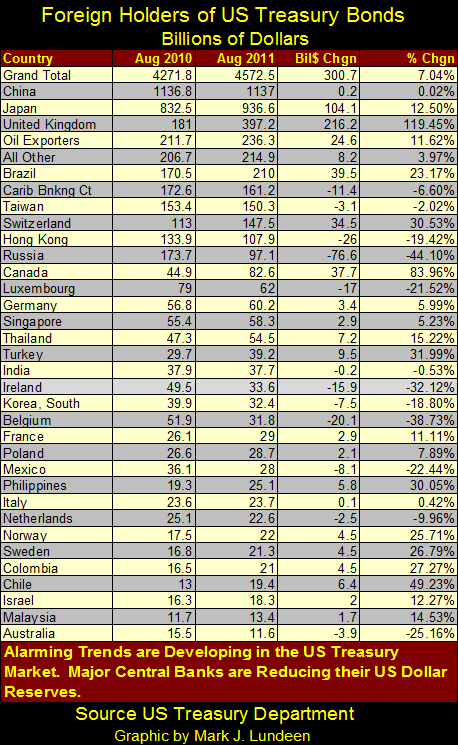
The first chart displayed the foreign CB's US T-debt reserves, but the Fed has also monetized $2.62 trillion of the US national debt. So, the Fed has purchased twice that of China's holdings, and its US Treasury bond reserves are an equivalent of 63% of all foreign CB's total holdings listed in the table above. These purchases of US Treasury debt are highly inflationary since they result in newly printed dollars being released into the banking system. Too bad oil and manufacturing jobs can't be created this easily!
The chart below gives the details of the massive "injections" of "monetary inflation" Doctor Bernanke has prescribed for the US financial system since the 2008 credit crisis.
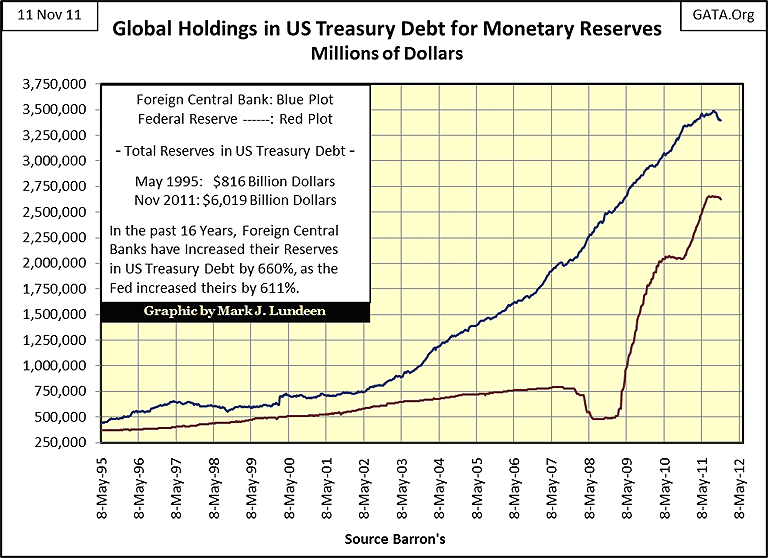
Even after the 2008-11 massive "injection of capital" into Wall Street's financial district (seen in the red plot above), the vital signs of Doctor Bernanke's patient have still not improved, as seen in the chart below: the financial stocks are still less than half their 2007 peak value.
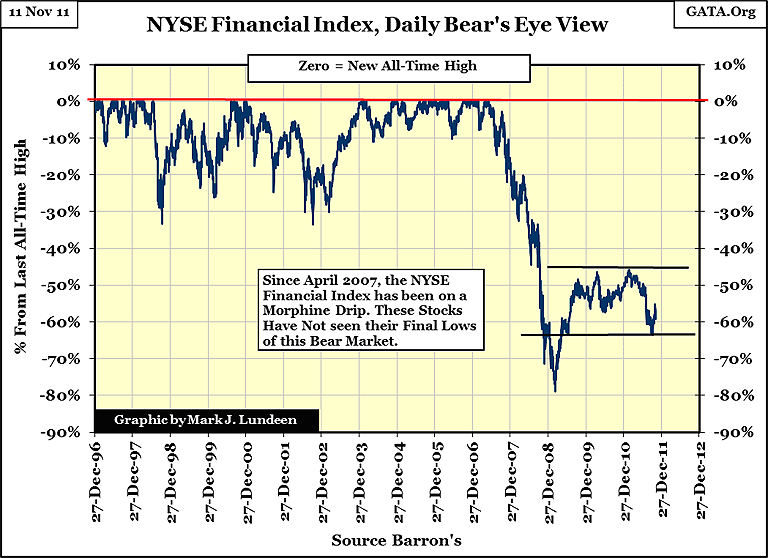
The ECB's euro is a particularly tragic unit of account; an academic social-engineering experiment that did not meet "designed parameters." Compare the euro to the American dollar. The dollar has been America's unit of account since the late 18th century. At the dollar's introduction, America's monetary authorities, having personally experienced the horrors of inflation from America's revolutionary war, saw the wisdom of only monetizing gold and silver into dollars. Growth in the modern sense was stunted, as there was so little money in circulation, but production of tonnes, barrels, and units of production soared just the same.
It took over one hundred years before America's know-nothing academics persuaded corrupt politicians to see the "policy potential" of monetary inflation. This is the euro's grievous defect; that from its start, it was created to facilitate "policy goals" not commerce. What proves this is that the current European bond crisis is one of sovereign, not commercial debt.
Below, we see as recently as 1995, only 16.8% of the US national debt was monetized (purchased with inflation) by the Federal Reserve and global central banks. Today, 40% of the current US National debt has been monetized by global central banks, with the Fed's share at 17.5% of the float. The expansion of debt by Washington is shocking, but what is even more shocking is the trend of global central banks monetizing an ever increasing percentage of America's Nat'l debt. This is bad, but what's worse is that the global banking system, using fractional reserve banking, then leverages these US Treasury bonds by at least a factor of 10; (more than 40 times may be closer to the truth). This will certainly end badly, as the world's banking system, using US Treasury debt for reserves, has created more interest bearing debt than the world's economy can possibly service. And when you, I, or the entire world can't pay our debts, we go bust, and get to shake Mr Bear's paws at the bottom.
As I've said many times before, Mr Bear isn't going anywhere until all this financial garbage has been properly disposed of.
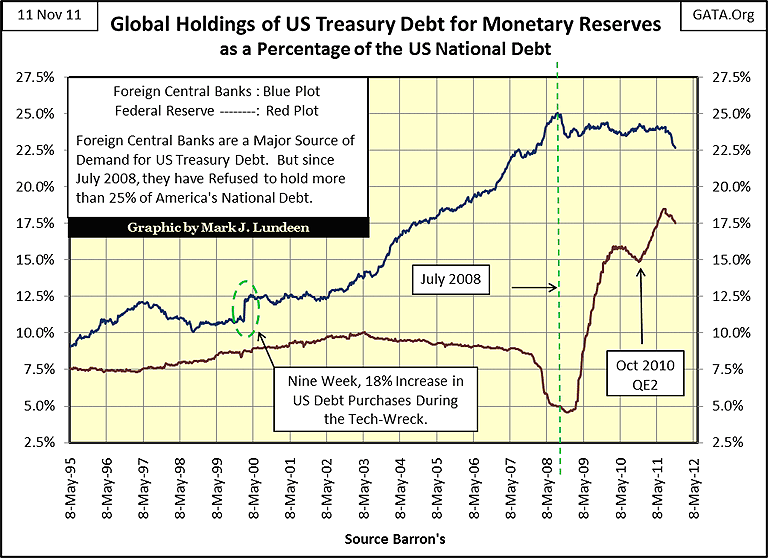
Since FDR became president in 1932, the US national debt has increased to grotesque proportions. No one who voted for Roosevelt could have predicted that seventy-nine years later, the $22.5 billion dollar national debt of 1933 would explode to $14.9 trillion in 2011. This is bad enough, but what is really horrible is how, over the decades, the Federal Reserve has actually monetized the US National Debt at a faster rate than Congress has driven America into bankruptcy.
So, what is my point? It's hard for me to find words to describe the monetary monstrosity we call "money", so I made a table to help illustrate my point: (note that dollars values are in billions). No one on TV seems to think the following is important; as they are always fixed on the US dollar, euro exchange rate. BUT the Federal Reserve has now monetized more US T-debt than existed when Doctor Greenspan became its Chairman in 1987; this fact really bugs me.
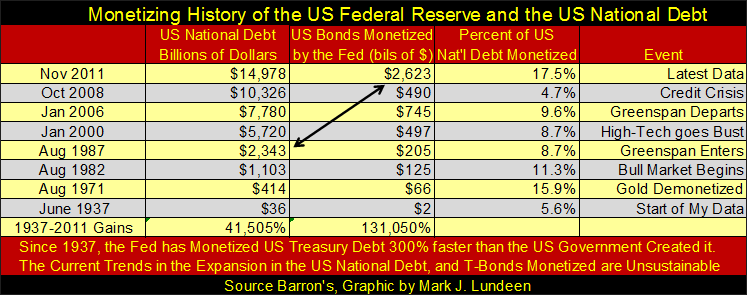
Below is a scary chart, the percent of the US Nat'l debt monetized by the Fed since 1953. This chart was calculated by dividing the Fed's holdings of US Treasuries by the US National Debt (all outstanding US Treasuries) over time. Looking at this plot, it seems pretty obvious that beginning with the March 2007 plunge, the "policy makers" at the Fed lost control of their destiny. We are living in a dangerous world.
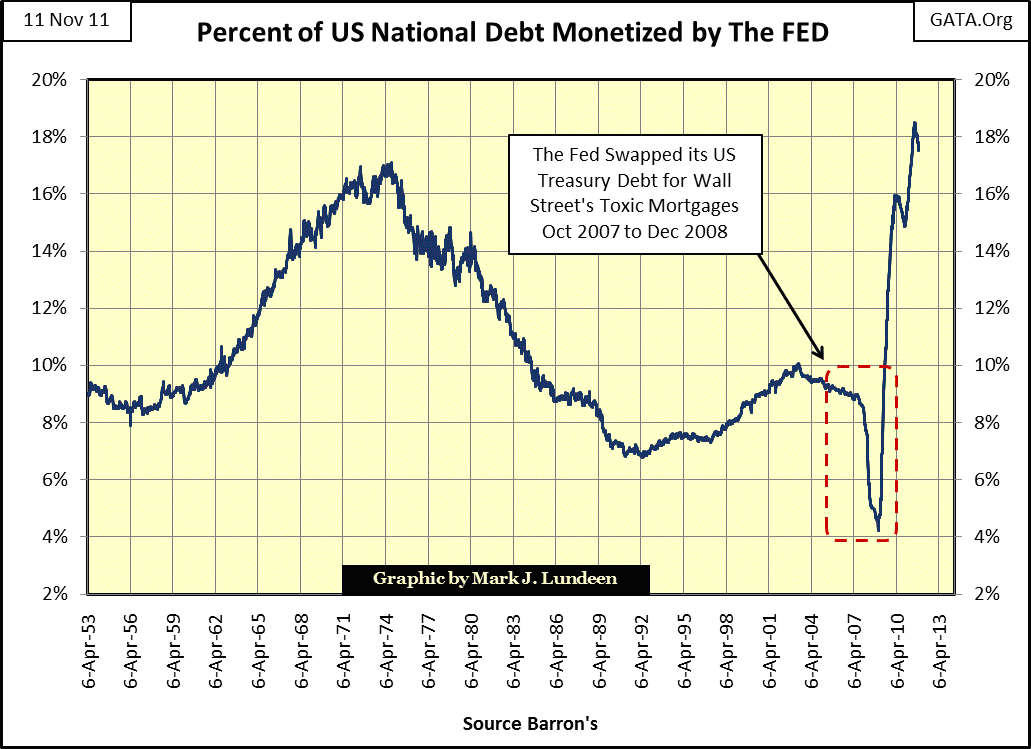
In a world such as ours, the best place to be is in gold and silver coins. After that I like mining stocks, and yes, exploration companies when taken in moderation. As far as what I really think of stocks and bonds, feel free to read this article again.
[email protected]
















